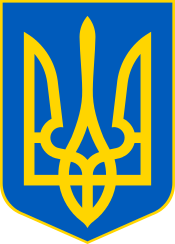Cossack Mamay
Cossack Mamay[1] (in less significant variants also named as Cossack banduryst, Ukrainian: Козак Мамай) is a Ukrainian folkloric hero, one of the standard characters in traditional Ukrainian itinerant puppet theater, the Vertep.
.jpg)
Overview
Cossack Mamay is encountered in legends, folk stories and proverbs. These became widely popular after the dissolution of the Zaporizhian Sich in 1775. Cossack Mamay is one of the most common characters in Ukrainian folk painting, from the late 17th century to the present time. In the hundreds of surviving paintings, Cossack Mamay is usually shown with a kobza – a lute-like musical instrument that is the symbol of Ukrainian soul; a horse, which represented both freedom and fidelity; and an oak with his weapons hanging on it symbolizing the people's strength. The paintings from the time of Koliyivschyna sometimes portray Mamay on the background of violent incidents involving Poles or Jews. [2]
Gallery
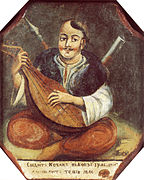 18th century
18th century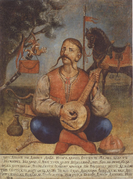 18th century
18th century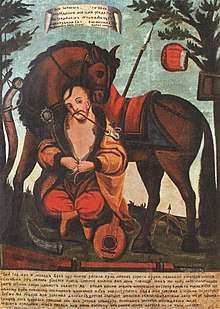 1728
1728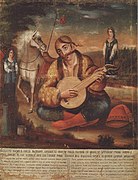 19th century
19th century_-_Google_Art_Project.jpg) Crimea 1780/1840
Crimea 1780/1840.jpg) 19th century
19th century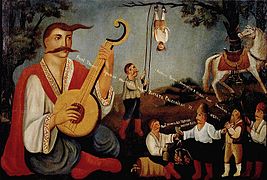
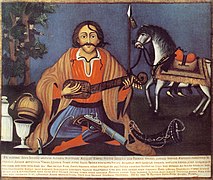 1855
1855.jpg) 1890
1890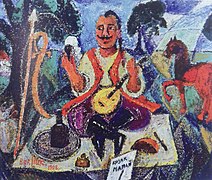 David Burliuk, 1912
David Burliuk, 1912- 2003
 Coin obverse
Coin obverse Coin, reverse
Coin, reverse
Cossack Mamay in art
Literature
- "No end to Cossack kin" - a novel by Olexandr Ilchenko.
- "Mamay" - a historical verse novel by Leonid Gorlach.
- "The Cossack Mamay Myth" - collection of poems by Ihor Kalynets.
Movie
In 2003, director Oles Sanin made the film "Mamay" at the Oleksandr Dovzhenko National Film Studio.
Music
In music, the image of Cossack Mamay was reflected in the songs of contemporary Ukrainian bands Komu Vnyz, and Vopli Vidoplyasova.
Street art
During the Revolution of Dignity, the artist Mykola Goncharov recreated the image of Cossack Mamaiya in graffiti and posters of the series "All you need is love", replacing the kobza with a Kalashnikov rifle, and the damask with a lit Molotov cocktail.
Cossack Mamay coin
On the 1997 coin minted by National Bank of Ukraine, Cossack Mamay is dressed in a rich coat with fur and sits with his legs crossed, smoking a pipe and playing a kobza. Traditional elements of Cossack military life are around Mamay: a horse with rich harness, tied to a spear with a flag planted into the ground; a green oak tree with a sabre hanging from it; a pistol and a stone powder case; Turkish kalpak (high hat), and a bottle of okovyta (Ukrainian for aqua vitae).
The coin edge has the inscriptions: (Ukrainian: Козак Мамай, Cossack Mamay) – at the left and (Ukrainian: Лицар волі і честі, Knight of Freedom and Honor) – at the right. On top, these inscriptions are separated with a small flag at the spear point and, underneath, a conventionalized guelder-rose spray.
The Mamay coin is from the "Heroes of the Cossack Age" series, Ukrainian commemorative and jubilee coins.
See also
- History of the Cossacks
- Zaporizhian Host
References
- Олександр Галенко Рецензія на: Козак Мамай: феномен одного образу Студії мистецтвознавчі. – К.: Iнститут мистецтвознавства, фольклористики та етнології iм. М.Т.Рильського НАН України, 2009. – №1 (25)
- "COSSACK MAMAY: One Image Phenomenology"-Stanislav Bushak (Rodovid-Oranta 2008), p.245-293
- Бушак С. М. Сміхова культура українського народу у творах «Козак Мамай» та «Запорожцях» Іллі Рєпіна // Скарбниця української культури. Збірка наукових праць. — Вип. 3. / Чернігівский історичний музей. – Чернігів: Сіверянська думка, 2002. — C. 72–79.
- Kozak Mamay. Amazing collection of images collected by one individual. Some paintings dating from the mid-17th century.
External links
| Wikimedia Commons has media related to Cossack Mamay. |
- mamay.ch, Kozak Mamay. MAMAY'S ALIVE, HE JUST WAS THINKING.
